
Vitamix VS Ninja - Blender Comparison
If you are considering a blender purchase, you might have plenty of questions swirling around about which blender is best. With blenders ranging in price from a hundred to several hundred dollars, it is important to know which machine will perform best for your most common blending tasks. Perhaps you are considering a more cost-effective option like the Ninja blenders, or maybe you are wondering if a higher-dollar blender such as the Vitamix is worth the splurge. We put the Ninja Mega Kitchen System and the Vitamix Ascent A2500 head-to-head on a variety of common blending tasks to help you determine which will work best in your kitchen!
Top Blenders
Is a Vitamix Blender Worth it?
If you’ve been looking to purchase a blender, you might be wondering why Vitamix blenders are so expensive. Why shouldn't you get a $99 blender from a big-box store? What makes Vitamix worth the price? There are many reasons why you'd want to invest in a high-powered blender like Vitamix. Here are the top reasons we choose Vitamix over a cheaper blender any day:
- Build Quality: Vitamix blenders are designed with restaurant-grade heavy-duty parts. The motors in their blenders are much larger than anything found in a box-store blender. Cheaper blenders will use plastic gears and lower-quality plastic jars that can break down much more quickly over time, which means you'll be replacing your blender more often.
- Multi-Year Warranties: Vitamix blenders are covered by a standard 10-year warranty. They stand behind their products because they are built to last. Other cheaper blenders may only be covered by a 1-year warranty, meaning you will have to purchase your next blender out of pocket.
- Restaurant-Quality Results: Have you ever wondered why blended drinks from Starbucks or your favorite smoothie shop are creamier and smoother than homemade drinks? Chances are they are using a high-powered blender such as a Vitamix. Cheaper blenders will leave chunks and unblended ingredients behind, which can ruin your smoothie experience. Only a high-power blender will let you achieve restaurant-quality results at home!
- Made in the USA: Vitamix blenders are made right here in the USA, which supports American workers and manufacturers.
The Test Subjects
|
Blender |
Ninja Mega Kitchen System BL770A 30 |
|
|
Motor Power |
1500W / 2.2 HP |
1500W / 2 HP |
|
Speed Options |
10-Speed Manual Control |
3-Speed Manual Control |
|
Blade Style |
Thick, Blunt Blades |
Plastic-to-Plastic |
|
Base to Jar Connection |
Metal-to-Metal |
Thin, Sharp Tower of Blades |
| Controls |
Speed Dial & Physical Switches |
Flush-Mounted Push Buttons |
|
LCD Display |
Yes |
No |
| Included Jars |
|
|
|
Warranty |
10-Year |
1-Year |
Jar Construction
The Ninja Mega Kitchen System comes with 4 Jars: a 72oz blender pitcher, 8-cup food processing bowl, and two 16oz NutriNinja smoothie cups. All are constructed from BPA-free plastic. Though the jar appears sturdy, it did not pass our stress test for durability. The Ninja’s jar cracked and chipped after a single fall from the top of a refrigerator, making it unable to survive inevitable accidents.
The Vitamix Ascent Series blending jars have an updated design that makes them easier and more efficient to use. The most notable feature is the Self-Detect wireless technology integrated into the jar that allows the blender to recognize the size of the jar and adjust the power level and maximum blend time to avoid damaging the jars. In addition to the advanced technology, the Vitamix jars are extremely durable. We performed the same stress test on the 64oz low-profile jar, and it did not have any chips or cracks after being dropped from the top of a refrigerator. Vitamix blender jars are durable enough to live through everyday drops and falls.
Ninja's blender jars are very brittle and not very strong. This one broke after falling from the top of the refrigerator just once.
Blade Style
Another design difference between Ninja and Vitamix blenders is the blade style. Vitamix features blunt blades with a slight taper on the edges. The blade is 4-pronged and has pointed tips, which help to create a powerful vortex that pulverizes foods. All Vitamix blenders come equipped with a tamper tool that allows you to push thicker blends back down into the blade, ensuring a thorough blend.
The Ninja, however, is famous for its tower of sharp blades. The stacked, sharp blades slice through ingredients rather than pulverize them. Like your kitchen knives, the blades on the Ninja wear down over time and become less and less effective.
The Vitamix blade is secured to an all-metal base, while the Ninja’s blades are secured to plastic.
Controls
The Ascent A2500 features Vitamix’s classic manual speed dial, which has 10-speed settings to allow for total control. The A2500 also includes 3 presets for hot soup, frozen desserts, and smoothies. When a preset is selected, the LCD timer counts down to show you the time remaining on your blend. The toggle switches on either side of the control dial are sturdy and easy to operate. One side allows for pulse blending, while the other acts as the pause and start switch. The Vitamix’s controls make it easy to customize your settings to your recipe.
The Ninja has a flush-mounted button interface, which can be slightly difficult to operate. The buttons are not very responsive and can be a little confusing when you are programming the blender for certain recipes. There are no pre-programmed timed functions on the Ninja, contrary to the labeling on the buttons. While the 1, 2, and 3 buttons are labeled with Dough, Blend, and Crush, these are simply suggested speeds for your recipe and do not feature timed functions. Additionally, the Single Serve button will only operate with the personal-sized jar. The Single Serve button will not turn on with any other blender jar attached.
Vitamix gives complete control with 10 speed settings and easy-to-press toggle switches. Ninja has flush-mount buttons that take a press or two to get going.
Drive Socket & Blade Assembly
Vitamix uses metal for both the gear coupling on the blender jar and the drive socket on the base. This allows for longer-lasting use, as the metal will not wear down as easily over time. The Ninja, however, uses plastic for both the gear couplings and the drive sockets, which can easily wear down and break over time.
Metal gears and couplings can handle more torque and will last longer than plastic. Vitamix is metal-on-metal and Ninja is plastic-on-plastic.
Power
Both the Vitamix and the Ninja blenders boast a 1500W motor. Vitamix advertises that its motor can run at 2.2 HP, while the Ninja trails not far behind at 2.0 HP. The power of the motor can make or break a blender's performance ability, so we compared the Ninja and the Vitamix to see which blends best!
Recipe Test
Hummus is a smooth and creamy dip made from a base of chickpeas and olive oil. It can be flavored with just about anything to make a sweet or savory spread that is perfect on pita, crackers, veggies, fruits, and more. We had an abundance of onions, so we decided to start our blender comparison by making a carmelized onion-infused hummus. A good hummus should be thick and spreadable with no chunks or bits of food in it.
We were looking for how well each bender incorporated the ingredients to test the effectiveness of the blades and the engineering of the jar.
Recipe: Caramelized Onion Hummus
Blend time: 1 Minute
- Vitamix: We loaded the Vitamix with two cans of chickpeas, a splash of water, lemon juice, and our caramelized onions. It took about 1 minute for the Vitamix to completely puree our hummus from start to finish. The olive oil was completely emulsified with the liquid with no signs of pooling oil on top. The hummus had a satisfying airy and creamy texture with no signs of unblended ingredients. The final product was as spreadable as mayonnaise and tasted just as good as any hummus found at a high-end restaurant.
- Ninja - We used the same recipe and blend time with the Ninja, and it yielded significantly different results. Blending with the Ninja resulted more in a chickpea smoothie or thick soup. The Ninja struggled to blend the ingredients and flavors together, which resulted in an off-putting taste. The Ninja was not able to emulsify the hummus and left a pool of oil on top. The overall texture of the hummus was very liquidy and viscous compared to the thick & velvety hummus made with the Vitamix.
Ninja makes more of a chickpea smoothie compared to Vitamix's fluffy and creamy hummus. Ninja makes more of a chickpea smoothie compared to Vitamix's fluffy and creamy hummus.
Winner: Vitamix - Emulsification Expert
The jar design of the Vitamix makes it perfect for making hummus. The jar is engineered to create a vortex that pulls ingredients back down into the blades for superior blending. Because oil and water do not mix naturally, hummus must be made in a blender that is powerful enough to emulsify the ingredients. To emulsify oil and water, oil particles have to be small enough to surround water particles to prevent them from separating. The vortex effect created by the Vitamix jar was much more successful at emulsifying ingredients than the Ninja.
Powdered Sugar Test
This test was simple. We put sugar into each blender, hoping to pulverize and create powdered sugar. This tests the effectiveness of the blades. We added 1.5 cups of sugar to the Ninja and the Vitamix and blended on the highest setting for 30 seconds. We looked for a consistently fine, fluffy powder with no sugar crystals left unblended.
Recipe: Powdered Sugar
Blend time: 30 seconds
- Vitamix - After 30 seconds, the Vitamix was successful in creating a perfect powdered sugar. We sifted it through a fine-mesh sieve and did not find any full sugar crystals left over, leaving behind a nice sugary dust.
- Ninja - Unfortunately, the Ninja failed to make powdered sugar. We saw some of the sugar crystals trying to turn into powder after 30 seconds, but it was a grainy, sugary mess. Full sugar crystals were left over.
Vitamix's milling ability is far superior to Ninja's, despite their motors both being 1500W.
Winner: Vitamix- Master of Milling
Ninja has its signature tower of sharp blades running up the entire middle of the blender jar, whereas Vitamix has thick, blunt blades at the bottom of the jar. This is where the Vitamix blades and jar excel. Despite both having like-powered motors, Vitamix’s blade design is better equipped for making powdered sugar. Where the Ninja has a tower of blades that will easily slice and dice foods, Vitamix’s blunt blades spin so fast they actually crush ingredients because there is more surface area for tiny sugar particles to hit. This combined with the vortex effect of the jar makes sure foods are fully pulverized. This also makes Vitamix great for milling whole grains for different types of flours.
Hot Soup Test
One of Vitamix’s most notable and well-known features is the Hot Soup function, which lets you make soups without ever turning on your stovetop. The powerful vortex and ultra-quick blades create enough friction to let foods rise in temperature. Since the Ninja has the same size motor as the Vitamix Ascent A2500, we tested its ability to make hot soup to compare. We filled both blenders with ingredients for a simple broccoli cheddar soup and used similar settings to see if we could yield similar results.
Recipe: Cheddar Broccoli Soup
Blend time: 5 minutes 45 seconds
- Vitamix: After our ingredients were in the jar, we programmed the Hot Soup function. In a mere 5 minutes and 45 seconds, we had perfectly pureed cheddar broccoli soup. When we measured the temperature, the soup clocked in at 162°F and was literally steaming. Vitamix delivers on its claim of making HOT soup.
- Ninja: After 6 minutes of blending the same recipe in the Ninja Jar, the soup was tepid at best. The Ninja's soup was a chilly 70°F, colder than room temperature. Even after blending for so long, the soup was still not nearly as creamy and velvety as the Vitamix’s. It felt and tasted granular with bits of broccoli floating around.
Vitamix can make hot soup from cold ingredients, no stove required.
Winner: Vitamix - Hot Soup, No Stove Required
Of the two blenders, Vitamix was the only blender capable of making a hot, ready-to-serve soup. You can add cold ingredients straight into the Vitamix blender jar and conveniently make sauces, soups, or other hot purees. Despite the Ninja’s like-powered motor, the blades did not cause the friction needed to heat ingredients properly.
Ice Cream Test
As ice cream lovers, we were looking forward to this test the most. When making ice cream in a blender, we looked at how well the blenders could crush ice and how well the liquid ingredients froze around the crushed ice. Both of these elements are crucial for creating a blended ice cream. Pulverizing ice into tiny crystals and moving it at rapid speeds allows for a creamier, more frozen ice cream.
Recipe: Chocolate Ice Cream
Blending Time: 1 Minute
- Vitamix: Vitamix features a preset Frozen Dessert function, which is perfect for making ice cream. We added 4 cups of ice along with milk, cream, vanilla extract, and cocoa powder to the Vitamix and started the Frozen Dessert function. The ice quickly crushed and started to freeze up on the jar sides, so we used the tamper to push everything back down into the blades. After only one minute, we had thick soft-serve chocolate ice cream. The ice cream had very small ice crystals for a soft, smooth consistency. The ice cream was also able to hold its shape nicely.
- Ninja: We added the same ingredients to the Ninja blender jar and did not get the same results. The mixture from the Ninja was similar to a milkshake rather than a soft-serve ice cream. There were large chunks of ice, and the mixture was completely runny. If you enjoy diner-style milkshakes, the Ninja can make one easily. It is not fast enough to make ice cream like the Vitamix, however. Ninja does make a dedicated machine specifically designed for ice cream making called the CREAMi.
Vitamix pulverizes ice with blunt blades. Ninja struggles to get ice crystals small enough with its sharp, thin blades.
Winner: Vitamix - Ice Cream Anytime
Making ice cream in a blender is tricky, but Vitamix has the trifecta of design elements in order to do so. The combination of blunt blades, efficient jar vortex, and a tamper makes blending ingredients easy. The blunt blades provide a larger surface area for the ice to hit when blending. When ice hits the blunt side of the blade, it crushes into tiny pieces which lets the rest of the ingredients freeze. The Ninja’s blades slice ice instead of crushing it which prevents ice from breaking down into small enough crystals.
Bread Dough Test
Both the Vitamix and the Ninja blenders claim to be able to make bread dough right in the blender jar. We decided to make a simple bread recipe in both blenders to test this claim.
Recipe: White Yeast Bread
Blending Time: Varied Per Blender
- Vitamix: The Vitamix was once again successful at this mixing task. All flour was thoroughly incorporated and there was a good amount of gluten development, as shown in the photos.
- Ninja: The Ninja actually has its own dedicated blender jar with special kneading hooks for kneading dough, so we used that jar to give it the best chance. It appeared to be doing a good job of mixing the ingredients, but it did not develop gluten well. The dough was not very stretchy and easily broke apart when stretched.
Vitamix makes perfectly stretchy bread dough. Ninja's dough tears apart.
Winner: Vitamix - Kneads Your Dough
Vitamix won this test for us as well. While the crumb of the Vitamix bread loaf was evenly spaced, the crumb of the Ninja bread loaf was uneven and did not rise well. Even with Ninja having a dedicated bread dough hook with a special blender jar, the Vitamix was more successful at kneading bread dough and creating an overall better loaf.
Smoothie Test
Smoothies are what most folks make most often in their blenders. If this is the same with you, you'll want your blender to do the best job making those nutrient-dense, sippable meals. That means no chunks, no strings, and no grainy, gloppy messes to try to choke down. For this test, we wanted to see how small Ninja and Vitamix got all of our green smoothie ingredients.
Recipe: Green Smoothie
Blending Time: 1 Minute
- Vitamix: The Vitamix Ascent A2500 has a dedicated smoothie button that runs for 60 seconds. We used a variety of hearty fruits and vegetables including kale, carrots, apples, and brussels sprouts. We used this setting and did not need to use the tamper at all. The Vitamix did a great job blending all the ingredients with its vortex effect. As you can see in the photo below, there were no distinguishable bits of carrot, apple, or kale - it's entirely a nice, consistent green color. This made for a smooth mouthfeel. The pulp was very fine, and it didn’t feel grainy.
Same blend time, same ingredients, same power motor. The engineering from Vitamix far surpasses the Ninja.
- Ninja: The Ninja was not able to create a completely blended smoothie like the Vitamix. This test revealed the most dramatic difference between the two blenders. Where the Vitamix smoothie was completely homogeneous and one color, there were unblended pieces of foods clearly visible in the Ninja smoothie. Unblended hearty produce like kale and apple skin makes for an incredibly grainy and gritty smoothie, which can be unappetizing. Ninja did include an individual serving-size smoothie jar in the set, so we tried making a smoothie with it as well. We could not fit the full recipe we used in the previous test, so we halved it. The results were considerably better, with fewer distinguishable bits of fruits and vegetables compared to the standard Ninja jar. Even after using this blender, there were still clearly identifiable bits of apple peel and kale, as well as large chunks of carrots. This smoothie was better than the previous, but it was still no match for the smoothie made in the Vitamix blender.

The smaller Ninja jar did much better than its full size jar, but still was no match for Vitamix.
The results were considerably better, with fewer distinguishable bits of fruits and vegetables compared to the standard Ninja jar, but you can definitely still see chunks of apple skin and there were still some full-on carrot chunks in the smoothie we made. This smoothie was drinkable, but the Vitamix definitely out-did the Ninja in the smoothie test, like it did in all of the other tests we put the blenders through.
Winner: Vitamix
Vitamix was the clear winner for the smoothie test. Ninja blenders can't pulverize hearty greens and tougher veggies the way Vitamix blenders can. Nutrient-dense smoothies can be hard to stomach if not blended properly, and the Ninja fails to pulverize ingredients to a smooth consistency. If you are a smoothie drinker or have hopes of being one, the Vitamix blender is the best option for you.
After completing each test, it was clear the Vitamix blender outperformed the Ninja blender. Vitamix came out on top in every single test. Where the Ninja blender churned out sub-par blends, the Vitamix blender delivered on each claim made by the manufacturer. Further, the wear-resistant construction ensures it will last through years of use. While the price of a Vitamix is high, our test showed it is worth every penny. Investing in a Vitamix will guarantee a decade of silky smoothies, steaming-hot pureed soups, and homemade flours from whole grains.
Want to know more about Vitamix blenders? Check out our full review of the Vitamix Ascent series here, or give us a call at 866-852-4268 or email us at [email protected] and one of our customer service heroes would be happy to help!
Top Blenders
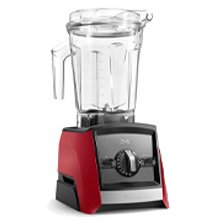
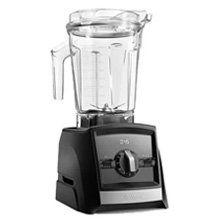

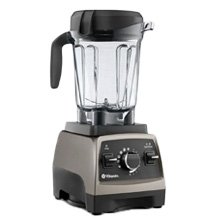

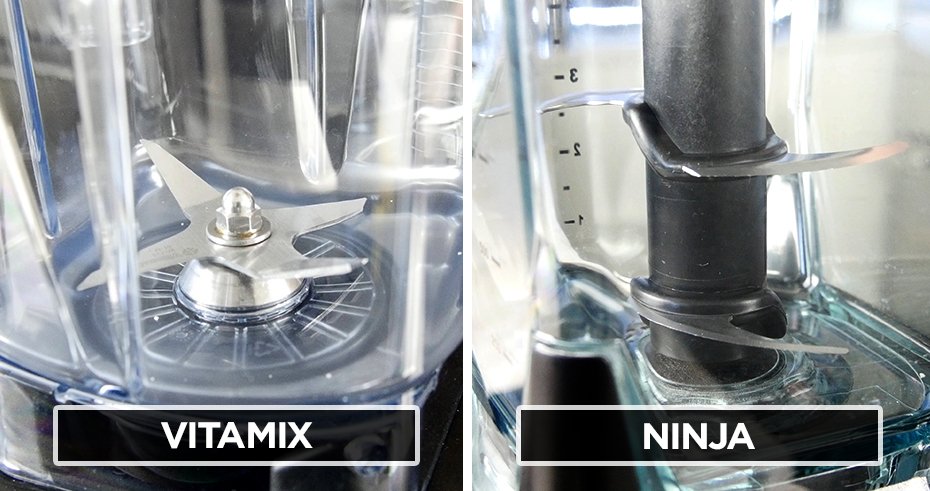
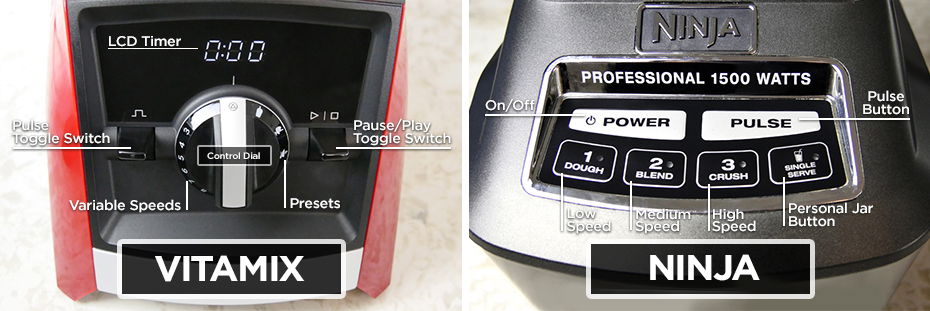



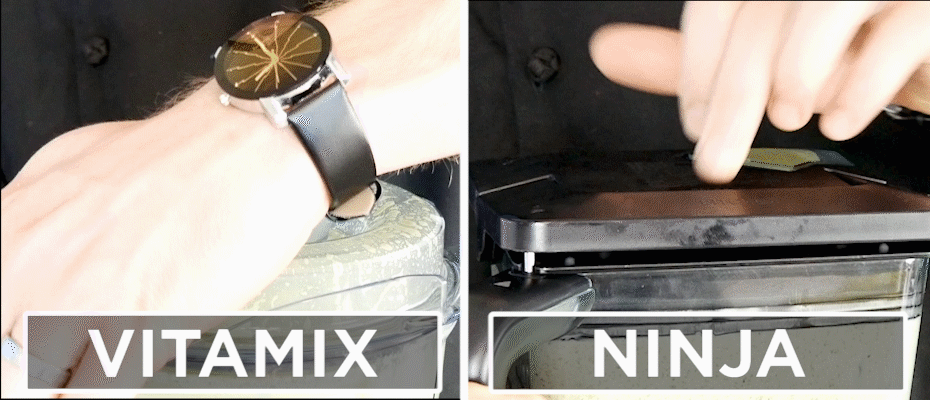

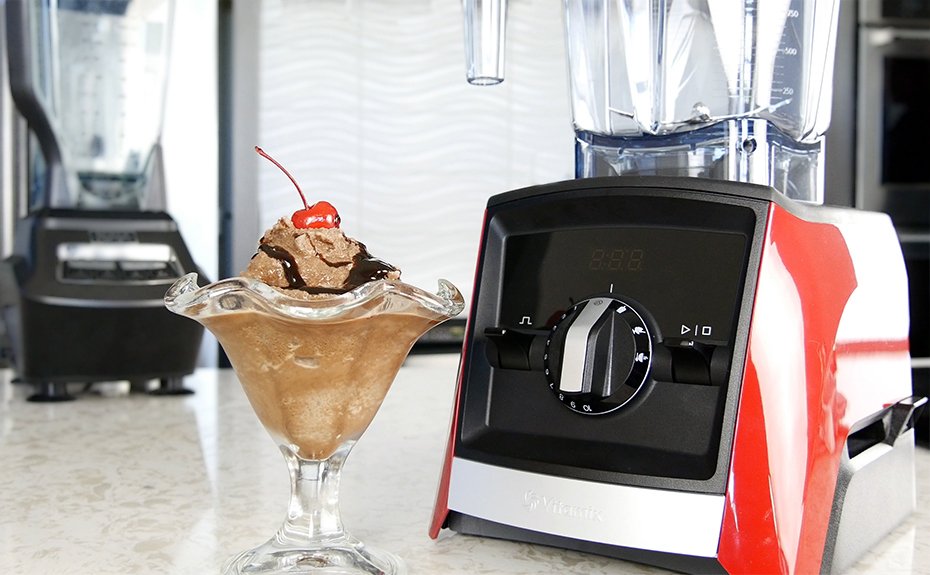

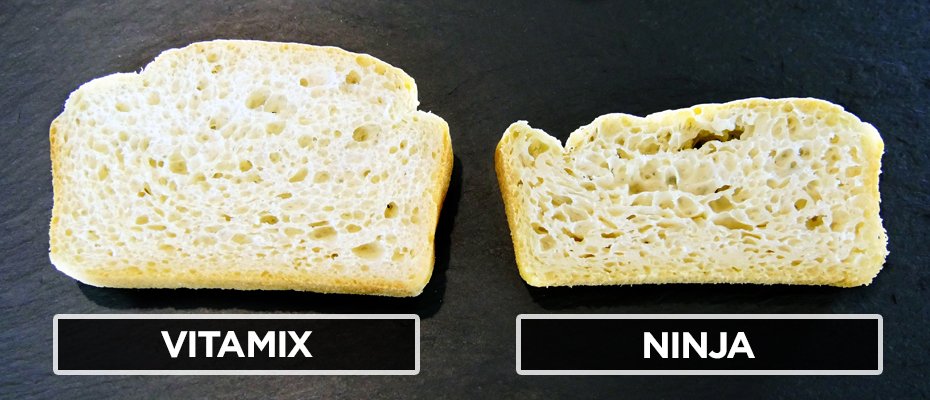
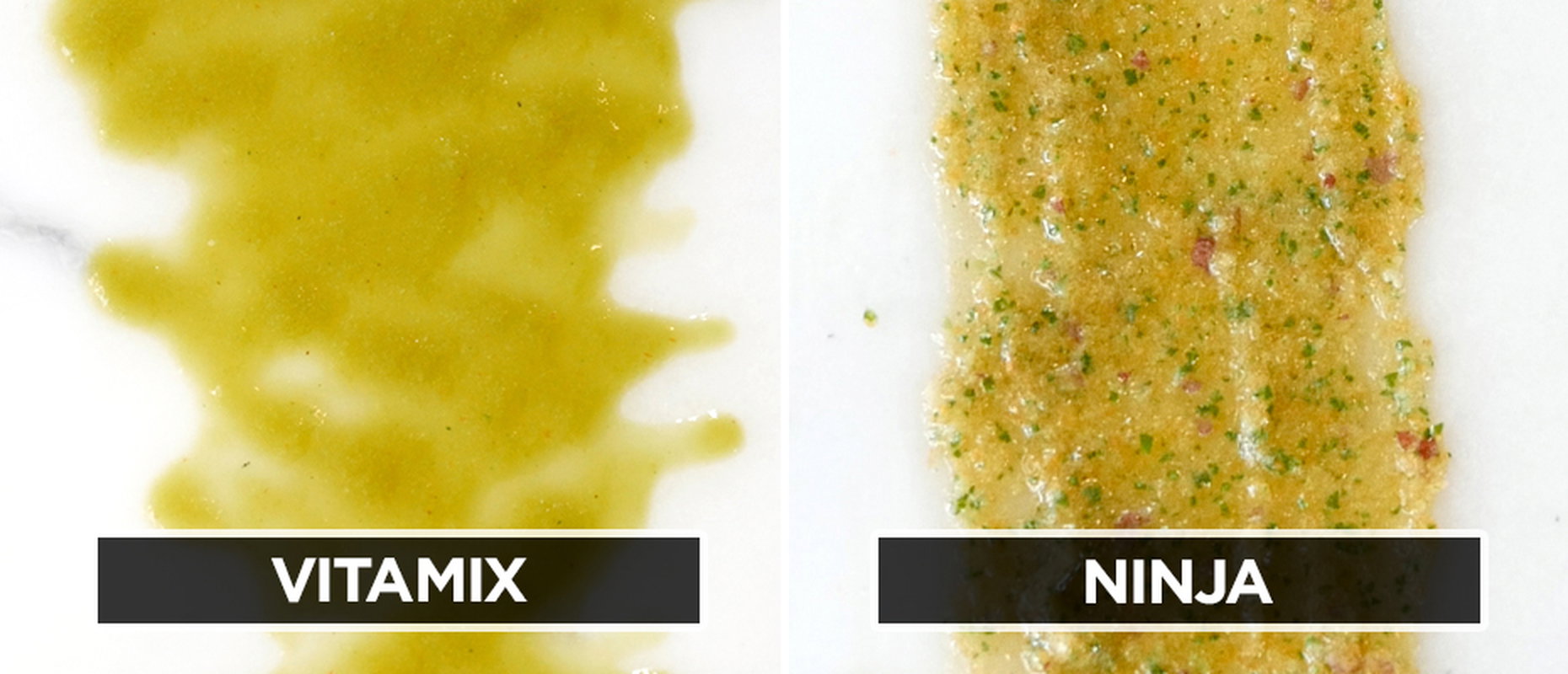



 KitchenAid
KitchenAid Fiesta®
Fiesta® Bosch
Bosch All-Clad
All-Clad Cuisinart
Cuisinart OXO
OXO Breville
Breville Le Creuset
Le Creuset Blendtec
Blendtec Wusthof
Wusthof Bormioli Rocco
Bormioli Rocco Vitamix
Vitamix Emile Henry
Emile Henry DeLonghi
DeLonghi Mason Cash
Mason Cash Nordic Ware
Nordic Ware Zwilling
Zwilling Kilner
Kilner Staub
Staub Swiss Diamond
Swiss Diamond TeakHaus
TeakHaus Ankarsrum
Ankarsrum LEM
LEM Weston
Weston Moccamaster
Moccamaster Mercer
Mercer All American 1930
All American 1930 CucinaPro
CucinaPro SMEG
SMEG Toddy
Toddy Everything Kitchens
Everything Kitchens
